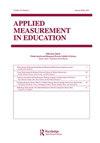Performance of Infit and Outfit Confidence Intervals Calculated via Parametric Bootstrapping
IF 1.1
4区 教育学
Q3 EDUCATION & EDUCATIONAL RESEARCH
引用次数: 2
Abstract
ABSTRACT Testing item fit is central in item response theory (IRT) modeling, since a good fit is necessary to draw valid inferences from estimated model parameters. Infit and outfit fit statistics, widespread indices for detecting deviations from the Rasch model, are affected by data factors, such as sample size. Consequently, the traditional use of fixed infit and outfit cutoff points is an ineffective practice. This article evaluates if confidence intervals estimated via parametric bootstrapping provide more suitable cutoff points than the conventionally applied range of 0.8–1.2, and outfit critical ranges adjusted by sample size. The performance is evaluated under different sizes of misfit, sample sizes, and number of items. Results show that the confidence intervals performed better in terms of power, but had inflated type-I error rates, which resulted from mean square values pushed below unity in the large size of misfit conditions. However, when performing a one-side test with the upper range of the confidence intervals, the forementioned inflation was fixed.通过参数自举计算输入和输出置信区间的性能
测试项目拟合是项目反应理论(IRT)建模的核心,因为良好的拟合是从估计的模型参数中得出有效推论所必需的。内嵌和整体拟合统计,广泛用于检测偏离Rasch模型的指标,受到数据因素的影响,如样本量。因此,传统上使用固定的内装分界点是一种无效的做法。本文评估了通过参数自举估计的置信区间是否比传统应用的0.8-1.2范围提供更合适的截止点,以及根据样本量调整的临界范围。在不同的错配大小、样本量和项目数量下对性能进行评估。结果表明,置信区间在功率方面表现较好,但由于在较大的失拟条件下均方值被推至1以下,导致i型错误率过高。然而,当使用置信区间的上界进行单侧检验时,上述通货膨胀是固定的。
本文章由计算机程序翻译,如有差异,请以英文原文为准。
求助全文
约1分钟内获得全文
求助全文
来源期刊

Applied Measurement in Education
Multiple-
CiteScore
2.50
自引率
13.30%
发文量
14
期刊介绍:
Because interaction between the domains of research and application is critical to the evaluation and improvement of new educational measurement practices, Applied Measurement in Education" prime objective is to improve communication between academicians and practitioners. To help bridge the gap between theory and practice, articles in this journal describe original research studies, innovative strategies for solving educational measurement problems, and integrative reviews of current approaches to contemporary measurement issues. Peer Review Policy: All review papers in this journal have undergone editorial screening and peer review.
 求助内容:
求助内容: 应助结果提醒方式:
应助结果提醒方式:


